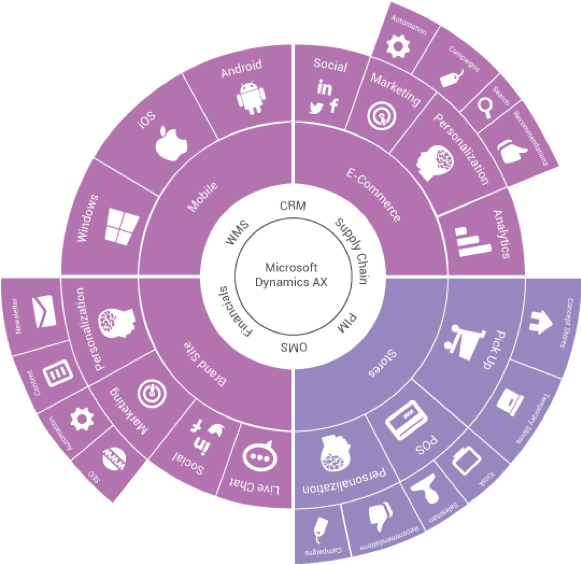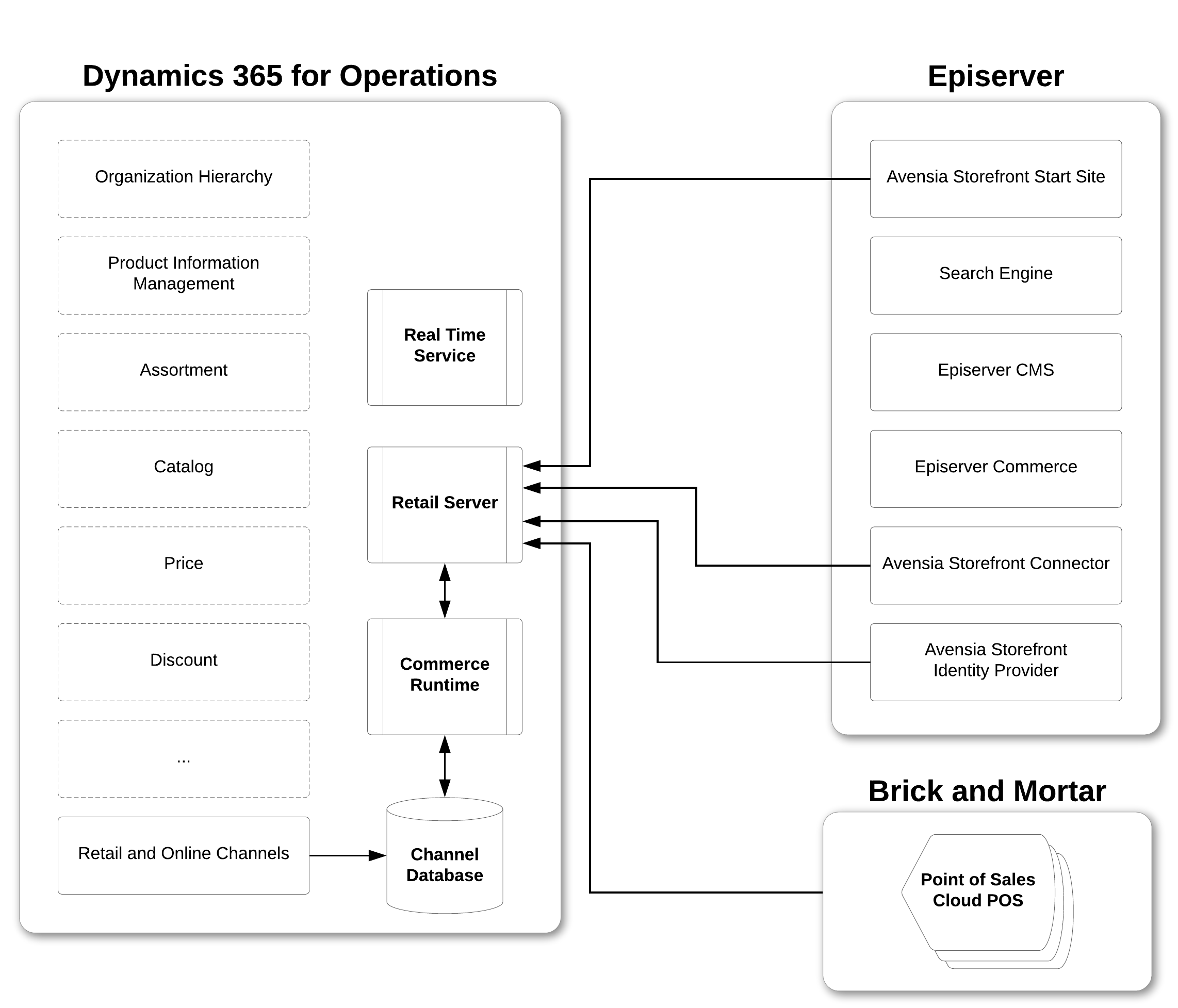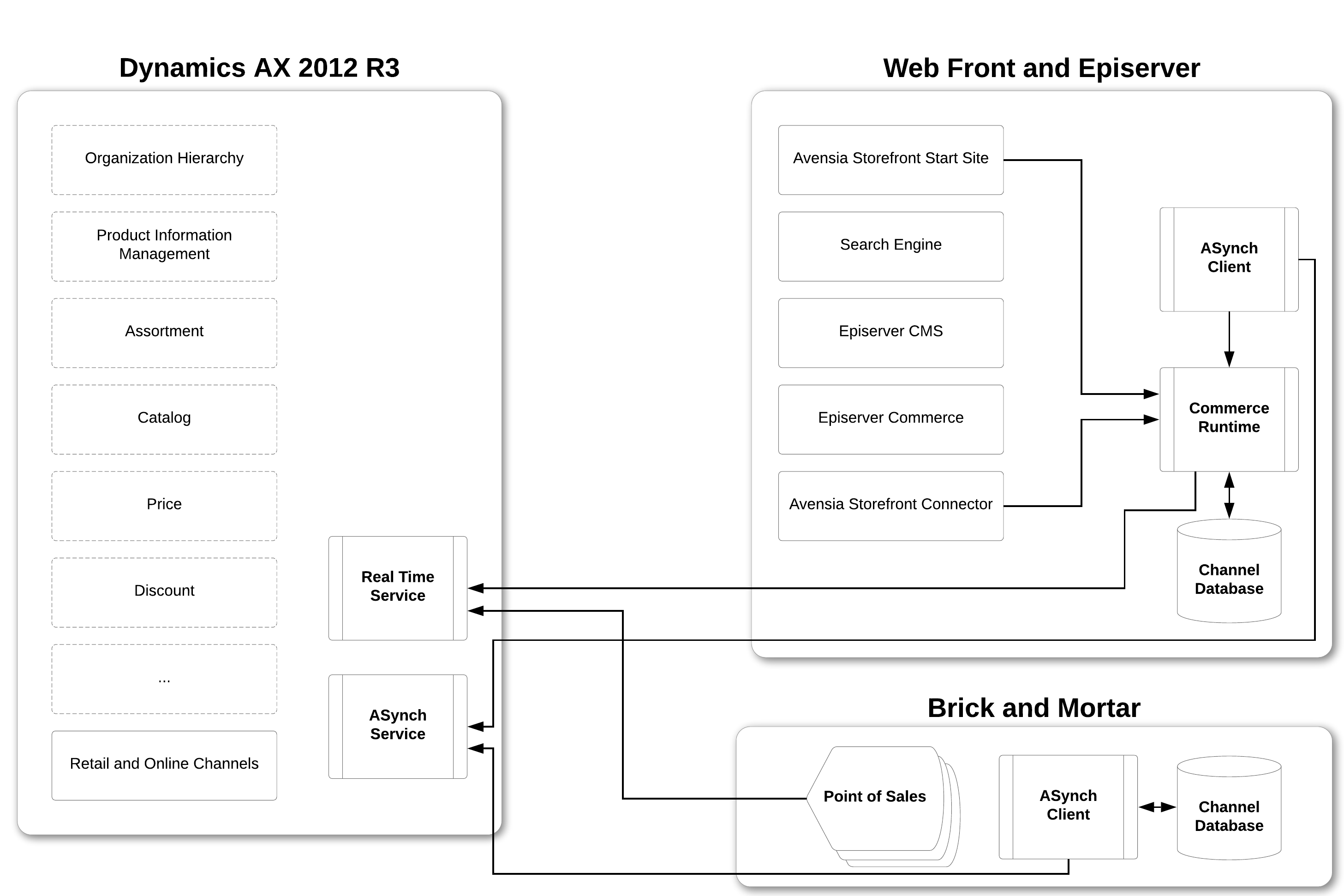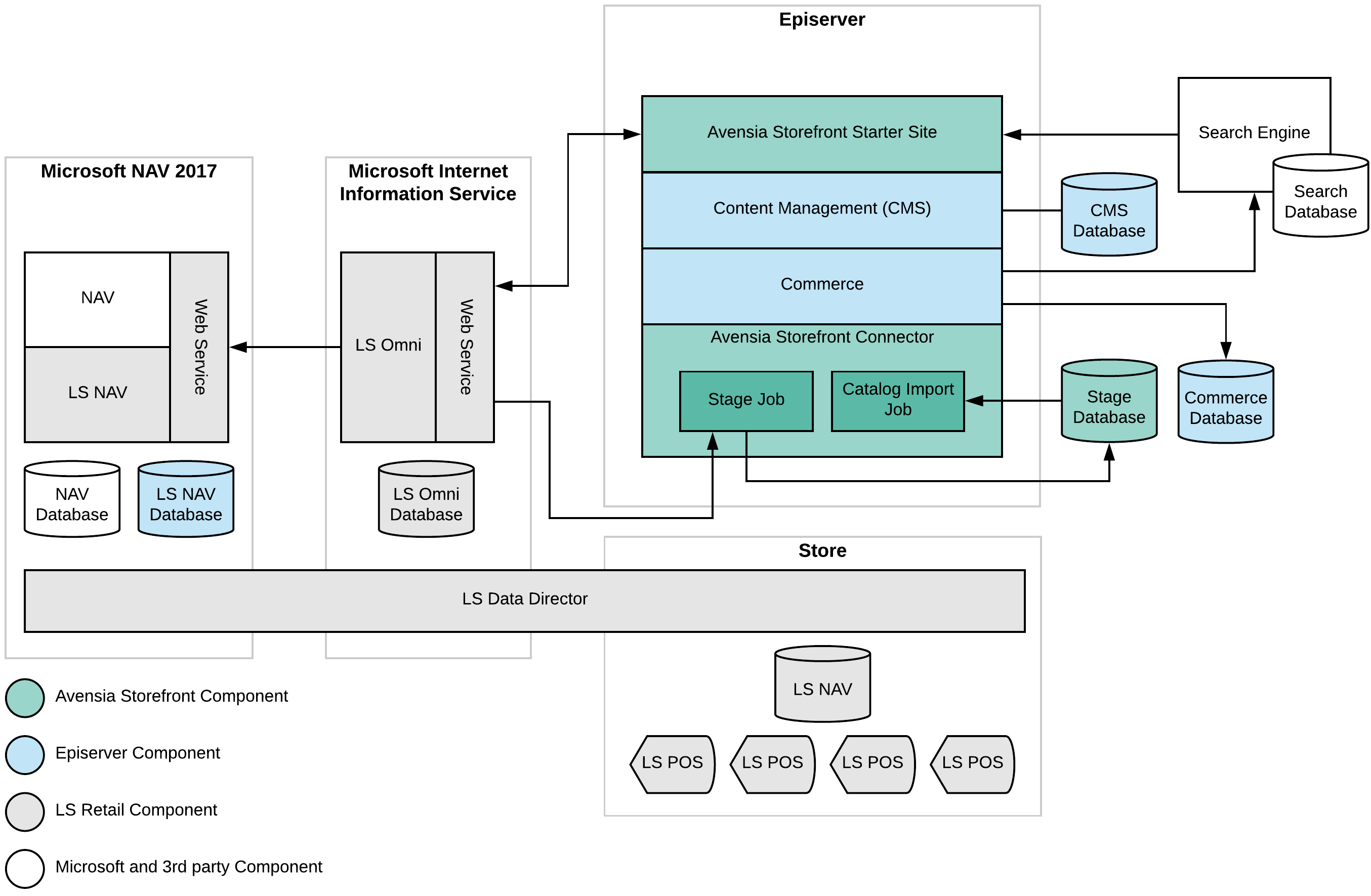Technical summary
For Partners
Storefront 365 connects Dynamics 365 for Finance and Operations, Dynamics 365 for retail and Dynamics AX 2012 R3, and exposes the online channel on the Internet. Storefront 365 uses the business logic provided by Dynamics and do not need any customizations or adoptions to support all retail rules set up in Dynamics. With Storefront 365 is Dynamics the master system and channel configuration and maintenance are made in the ERP system.
Storefront 365 Starter Site is a fully functioning web shop that uses one of the online channels defined in Dynamics 365 or Dynamics AX 2012 R3. The online channel can be a channel defined based on the requirements of a customer, or it could be any of the demo data distributed with Dynamics.
Any implementation of e-commerce is simple and cheap when using Storefront 365 with the starter site. The ERP specialist will be able to do a fit and gap analysis for the customer by running Storefront 365 starter site and define all gaps against the requirements of its customer. Storefront 365 uses standard functions and API only, and is easy to set up with an existing Dynamics installation.
Storefront 365 utilizes the omnichannel features that make Dynamics 365 and Dynamics AX 2012 R3 a unique platform. All channels are set up in Dynamics and distributed by Dynamics between all channels. Every channel has a consensus of the customer and what the customer has done.
Storefront 365 is used as a digital publishing portal for the e-commerce solution created by Dynamics-partners all over the world. Storefront 365 contains the technical solution needed to use Dynamics 365, Dynamics AX 2012 R3 or Dynamics NAV with LS NAV in Episerver CMS and digital publishing platform. It also contains a starter site that is used as fit-and-gap analyse and as a foundation to minimize the investments needed in a project startup since it includes all e-commerce features.
Storefront 365 implements the exposure of the online channels with a central hub of Dynamics 365 for Finance and Operations, Dynamics 365 for Retail, Dynamics AX 2012 R3 or Dynamics NAV with LS NAV.

The features available to use in Storefront 365 are divided into two major parts:
E-commerce
The e-commerce part is a webshop that displays the assortment of products defined for an online channel and gives the visitors and customers functions to search, browse and buy items. Orders are created in Dynamics and sent to the web site using the Storefront 365 Integration Framework. The webshop implements features that are important for a high conversion rate.
- Social. Within the web site are connections to social media such as Facebook available. Add-ons for Social Reach is available for Episerver. It is used to publish information on social media and to analyze any response on the published information. See http://world.episerver.com/articles/Items/Social-Reach-Package/ for more information.
- Marketing. Episerver is a digital marketing tool with a toolbox of features to use for marketing on a web site. With Avensia Storefront will campaigns created in Dynamics 365 be available in the web site. Banners, ads and enriched media is available to use and can be imported from almost any source.
- Personalization. Personalization means that the web content and the look and feel of the web site is automatically adjusted to each visitor. There are several ways to implement personalization using Avensia Storefront and Episerver. Customer specific assortments and prices are available from Dynamics and using Episerver Visitor Groups enables the web editor to create personal content on each page. Using 3rd party merchandizer software will improve the personalization even more.
- Analytics. Avensia Storefront and Episerver contain standard reports that a reporter may use for analytics of the site. Reports can be created and customized using Microsoft Reporting Services. Avensia Storefront Start Site may easily implement Google Universal Analytics.
Marketing
- Automation. Avensia Storefront is the source for marketing tools such as newsletters, confirmations, recommendations and similar marketing tasks that are performed by a 3rd party software or by Avensia Storefront.
- Search. Avensia Storefront supports any search engine available for Episerver. Search engines such as Lucene, Solr, Elastic Search, Apptus eSales and Episerver Find can be used in the web site. The search engine is used for high-performance rendering and to relevant search.
- Campaigns. Campaigns are created in Dynamics 365 or in a 3rd party PIM system and exposed in the web site. The campaigns may be exposed to specific customer segments and may be exposed in inspirational campaign pages or microsites.
- Recommendations. Recommendations are managed by a merchandize software like eSales from Apptus or Episerver Advanced. Recommendations are based on user behaviour and statistics and will always display products in an order that exposes the most relevant products topmost. Recommendations, like “Visitors who bought this, also bought” and similar are created automatically by the merchandizer. The merchandizer is a self-learning system added on top of the search engine.
Architecture Overview
Storefront 365 uses Episerver Digital Marketing Platform to implement a retail online store created and configured in Dynamics 365 or Dynamics AX 2012 R3. Storefront 365 uses the business logic in Dynamics used through the Retail Server or Commerce Runtime to ensure that all retail features in Dynamics are available in the publishing site.
Storefront 365 is used as a digital publishing portal for e-commerce solutions created by Dynamics-partners all over the world. Storefront 365 contains the technical solution required to use Dynamics in Episerver CMS and digital publishing platform. It also contains a starter site that is used as a foundation to minimize the investments needed in a project start-up since it includes all e-commerce features.



The features of Storefront 365 Integration Framework and Starter Site are the same regardless of the version of Dynamics used. There are however differences in the architecture that depends on the version of Dynamics used. The differences in the architecture are depending on the business logic of Dynamics.
- Dynamics AX 2012 R3
- The business logic used by the Avensia Storefront Starter Site is implemented by Microsoft in the Dynamics Commerce Runtime.
- User account information is stored and managed in Episerver Customer manager. Customers are however created and maintained in Dynamics AX.
- The New Dynamics AX (AX7)
- The business logic used in the Avensia Storefront Connector for publishing an online channel is implemented by Microsoft in the Dynamics Commerce Runtime since the Retail Server does not include the e-commerce Framework features of publishing a channel.
- The business logic used by the Avensia Storefront Start Site is implemented by Microsoft in the Dynamics Retail Server.
- The Identity Provider is part of Avensia Storefront and used for user authentication by Avensia Storefront and Dynamics Retail Server. User account information is stored and maintained in the identity provider. Customer information is stored and maintained in Dynamics.
- Dynamics 365 for Finance and Operations, Dynamics 365 for Retail
- The business logic used by the Avensia Storefront Connector is implemented by Microsoft in the Dynamics Retail Server.
- The business logic used by the Avensia Storefront Starter Site is implemented by Microsoft in the Dynamics Retail Server.
- The Identity Provider is part of Avensia Storefront and used for user authentication by Avensia Storefront and Dynamics Retail Server. User account information is stored and maintained in the identity provider. Customer information is stored and maintained in Dynamics.
- Microsoft NAV with LS NAV and LS Omni
- The business logic used by Avensia Storefront Connector is implemented by LS Retail in the LS Omni Server.
- The business logic used by Avensia Storefront Starter Site is implemented by LS Retail in the LS Omni server.
- User account information is stored and managed in Episerver Customer Manager. Customers are however created and maintained in Dynamics NAV.
Storefront 365 implements all e-commerce features setup in Dynamics AX, Dynamics 365 for Finance and Operations, Dynamics 365 for Retail and Dynamics NAV with LS NAV in a B2C and B2B online channel, such as:
- Publishing a retail online channel defined in ERP.
- All web pages in an online retail shop, such as start page, category page, product details page, checkout page, confirmation page, a search result page and My Pages page including customer profile and order history.
- The cart features so the visitor of the site can add, edit and remove items from the cart. The cart is calculated using all price rules defined in ERP and depending on the channel and logged in customer.
- Create a sales transaction that is synchronized with ERP.
- Retrieve order history for all sales orders and sales transactions created for a logged in user in any channel.
- Customer creation so that a visitor can register as a customer in an omnichannel solution.
- Customer login and log out.
- Maintenance features for recurring maintenance.
- Endpoint for Microsoft Flow integration for inbound and outbound connectors.
Avensia Storefront consists of two components.
- Avensia Storefront Integration Framework.
- Avensia Storefront Starter Site.
The connector stages, reads, validates, transforms and writes the information of a published retail online channel into Episerver. The connector also sets the online retail channel in Dynamics in state Published. The start site uses the channel information in a fully functioning online shop. The Avensia Storefront Connector may be extended by Dynamics partners to fulfil any customer specific requirements.
The starter site has been created to be used in a fit and gap analysis of the business implementing an online channel. By using the start site are all common e-commerce features already implemented, and the client can identify the gaps between the business requirement and the starter site. The starter site is also used for demo scenarios. The starter site is delivered together with User Stories defined for all features in the site. The user stories may be used in a fit and gap analyse and as requirements for client implementation.
The starter site reduces the investments needed to create an online retail experience since all e-commerce features already are implemented. For Dynamics 365 the start site uses Microsoft Azure Active Directory B2C for customer authentication and authorization. For Dynamics AX the start site uses Episerver Customer manager. The identity provider can be replaced or complemented by other providers, such as Google, Facebook or Azure Active Directory supporting OAuth 2.0.
Storefront 365 uses the business logic in Dynamics through the Retail Server or Commerce Runtime, depending on Dynamics version used, and uses the standard features of Episerver CMS and Commerce. There are no customization or encapsulation of the business logic. This ensures that the retail online channel supports all retail business logic defined in the Dynamics Retail module. It also minimizes the efforts needed to upgrade Dynamics and Episerver versions.
All CMS features in Episerver are supported since Avensia Storefront uses the standard framework of Episerver. This ensures that other solutions and add-ons in Episerver are supported.
Versions of the ERP System
There are architectural differences between the major releases of Avensia Storefront. The differences depend on the architecture of Dynamics since every version of Avensia Storefront corresponds to a certain version of Dynamics.
Dynamics has gone through some major architectural changes in the latest releases. The most important changes that are recognized by the channel implementations are the business logic and the publishing logic provided by Dynamics.
- Dynamics AX 2012 R3 releases. Avensia Storefront uses the Dynamics Commerce Runtime (CRT) that is distributed with the Dynamics AX releases for all business logic that is mastered by Dynamics AX. The channel database is managed by a Microsoft SQL Server shared by the web front platform. Data is synchronized between Dynamics AX and the channel database by Dynamics ASynch Service and ASynch Client. Both are distributed by Dynamics distribution package.
- The New Dynamics AX (AX7). With the release of the new Dynamics AX was the Commerce Runtime encapsulated by the Retail Server for all business logic, except for the publishing logic used in the Dynamics e-commerce Framework. The channel database was moved into Dynamics AX and accessed through the Retail Server, except for channel publishing logic that still required access to the database. The client used in previous versions of Dynamics AX has been replaced by a web client that is accessed using a web browser. The ASynch Service and the client were removed and are instead included in the Dynamics AX core.
- Dynamics 365 for Finance and Operations, Dynamics 365 for Retail. With Dynamics 365 was all business logic encapsulated by Dynamics Retail Server, including the publishing of an online channel.
- Microsoft NAV with LS NAV and LS Omni. With the extension of LS NAV, created by LS Retail and distributed through their 260 or more partners worldwide, have NAV got the retail support needed to create a modern omni retail solution. The service LS Omni provides the online channels, called Web Store, with a centralized service for business logic. The architecture is similar to the Retail Server used in Dynamics 365.
NOTE!
The expression Dynamics will be used in this document to describe any version of Dynamics AX or Dynamics 365 for Finance and Operations or Dynamics 365 for Retail. In many cases where there is a difference in the versions will the explicit version of the product be used.